Effective Business Communication Skills: Analysis and Action Plan
VerifiedAdded on 2020/03/16
|13
|3304
|164
Report
AI Summary
This report provides a comprehensive analysis of effective business communication, focusing on diagnostic tools and strategies for improvement. It begins with an overview of the fundamental elements of business communication, including verbal, non-verbal, and written forms, and highlights the importance of interpersonal skills. The report then details five diagnostic tools: the Personal Report of Public Speaking Anxiety (PRPSA), Talkaholic Scale (TAS), Personal Report of Intercultural Communication Apprehension (PRICA), Nonverbal Immediacy Scale-Self Report (NIS-S), and Self-Perceived Communication Competence Scale (SPCC). Each tool is described, along with the student's personal scores and interpretations, revealing areas of strength and weakness in communication skills. The report further explores professional interactions over the past 12 months that helped overcome communication issues such as public speaking anxiety and lack of non-verbal communication skills. A literature review provides context on the significance of effective communication in the business world, emphasizing public speaking skills, communication models, and the impact of non-verbal cues. The report concludes by identifying communication issues like public speaking anxiety and lack of non-verbal skills and proposes an action plan for improvement. The report aims to enhance professional development by addressing communication challenges.
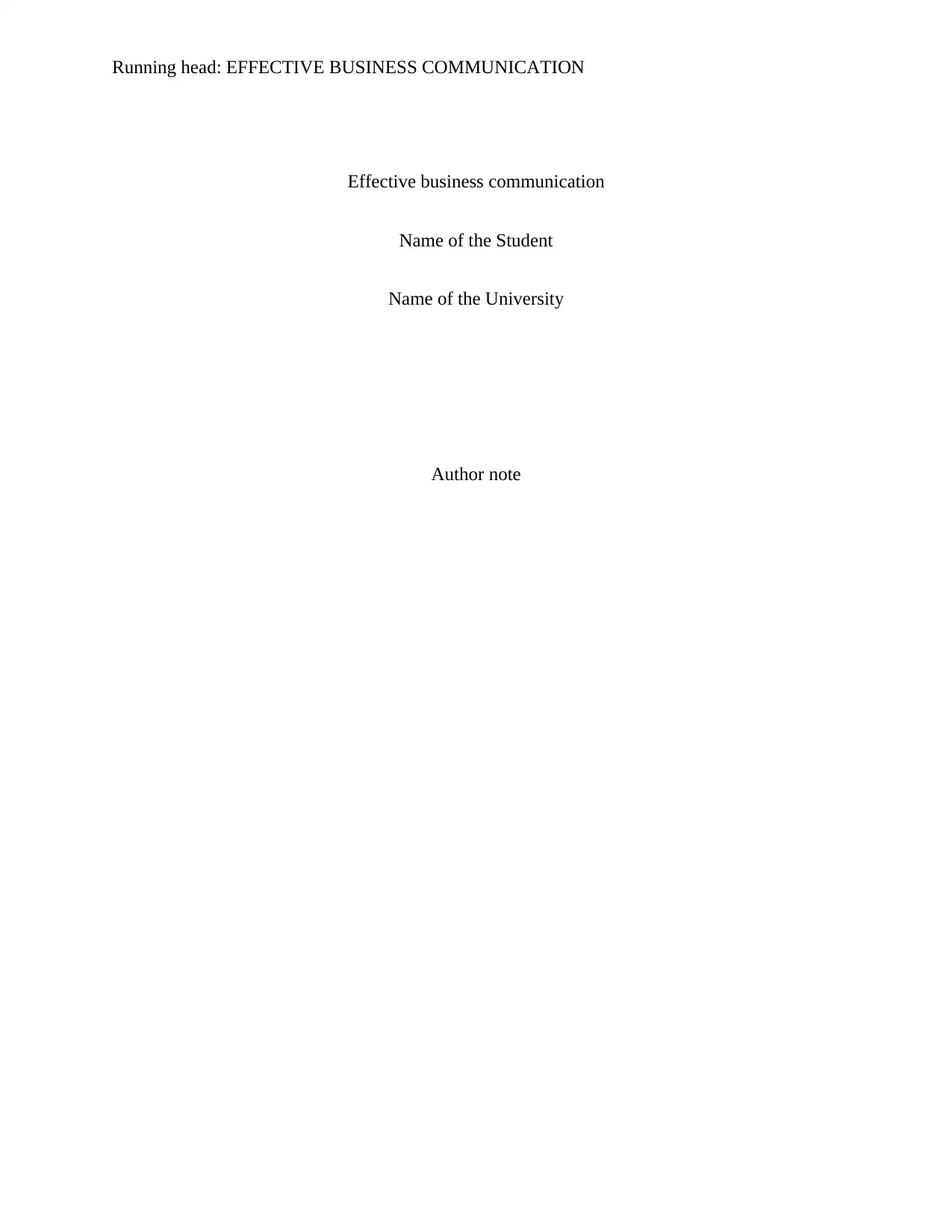
Running head: EFFECTIVE BUSINESS COMMUNICATION
Effective business communication
Name of the Student
Name of the University
Author note
Effective business communication
Name of the Student
Name of the University
Author note
Paraphrase This Document
Need a fresh take? Get an instant paraphrase of this document with our AI Paraphraser
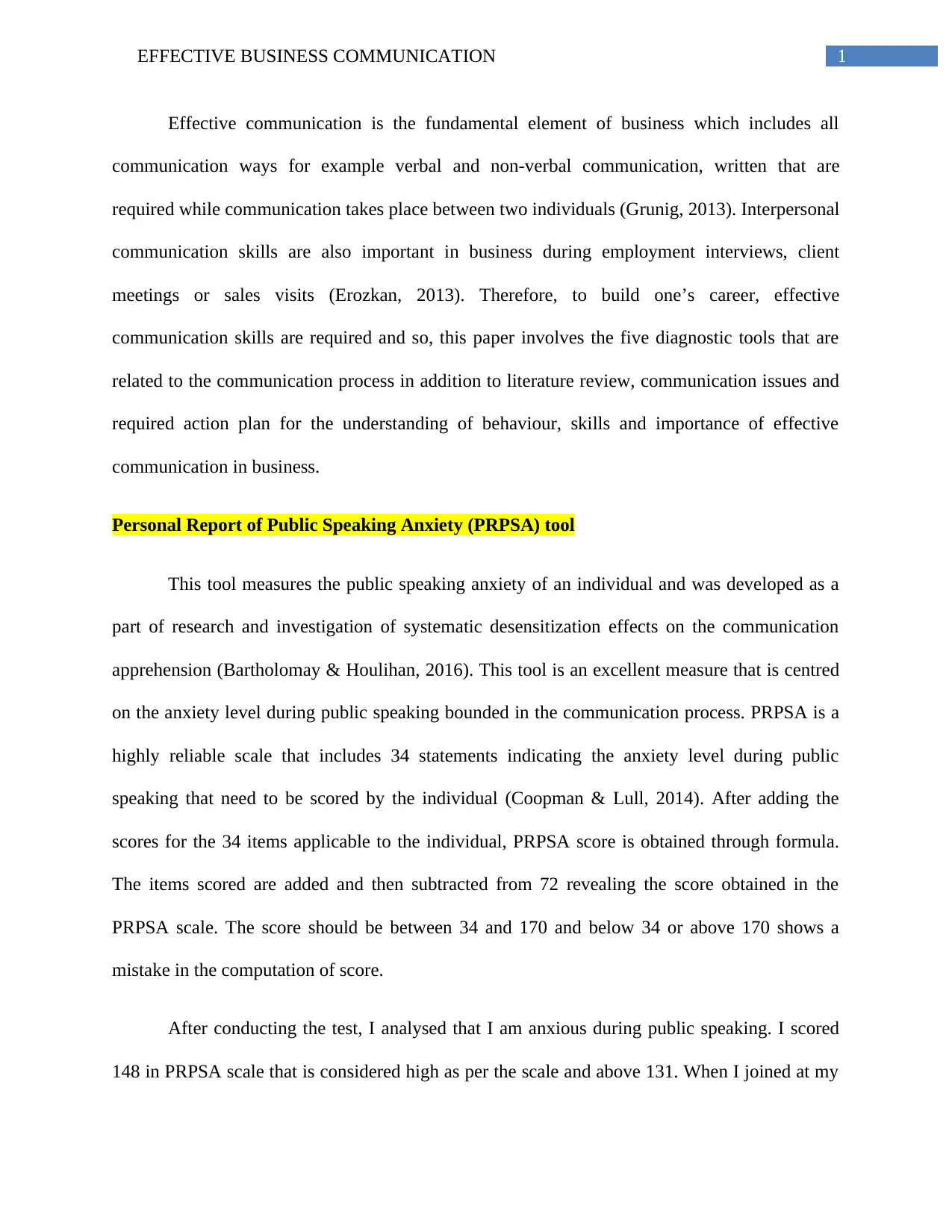
1EFFECTIVE BUSINESS COMMUNICATION
Effective communication is the fundamental element of business which includes all
communication ways for example verbal and non-verbal communication, written that are
required while communication takes place between two individuals (Grunig, 2013). Interpersonal
communication skills are also important in business during employment interviews, client
meetings or sales visits (Erozkan, 2013). Therefore, to build one’s career, effective
communication skills are required and so, this paper involves the five diagnostic tools that are
related to the communication process in addition to literature review, communication issues and
required action plan for the understanding of behaviour, skills and importance of effective
communication in business.
Personal Report of Public Speaking Anxiety (PRPSA) tool
This tool measures the public speaking anxiety of an individual and was developed as a
part of research and investigation of systematic desensitization effects on the communication
apprehension (Bartholomay & Houlihan, 2016). This tool is an excellent measure that is centred
on the anxiety level during public speaking bounded in the communication process. PRPSA is a
highly reliable scale that includes 34 statements indicating the anxiety level during public
speaking that need to be scored by the individual (Coopman & Lull, 2014). After adding the
scores for the 34 items applicable to the individual, PRPSA score is obtained through formula.
The items scored are added and then subtracted from 72 revealing the score obtained in the
PRPSA scale. The score should be between 34 and 170 and below 34 or above 170 shows a
mistake in the computation of score.
After conducting the test, I analysed that I am anxious during public speaking. I scored
148 in PRPSA scale that is considered high as per the scale and above 131. When I joined at my
Effective communication is the fundamental element of business which includes all
communication ways for example verbal and non-verbal communication, written that are
required while communication takes place between two individuals (Grunig, 2013). Interpersonal
communication skills are also important in business during employment interviews, client
meetings or sales visits (Erozkan, 2013). Therefore, to build one’s career, effective
communication skills are required and so, this paper involves the five diagnostic tools that are
related to the communication process in addition to literature review, communication issues and
required action plan for the understanding of behaviour, skills and importance of effective
communication in business.
Personal Report of Public Speaking Anxiety (PRPSA) tool
This tool measures the public speaking anxiety of an individual and was developed as a
part of research and investigation of systematic desensitization effects on the communication
apprehension (Bartholomay & Houlihan, 2016). This tool is an excellent measure that is centred
on the anxiety level during public speaking bounded in the communication process. PRPSA is a
highly reliable scale that includes 34 statements indicating the anxiety level during public
speaking that need to be scored by the individual (Coopman & Lull, 2014). After adding the
scores for the 34 items applicable to the individual, PRPSA score is obtained through formula.
The items scored are added and then subtracted from 72 revealing the score obtained in the
PRPSA scale. The score should be between 34 and 170 and below 34 or above 170 shows a
mistake in the computation of score.
After conducting the test, I analysed that I am anxious during public speaking. I scored
148 in PRPSA scale that is considered high as per the scale and above 131. When I joined at my
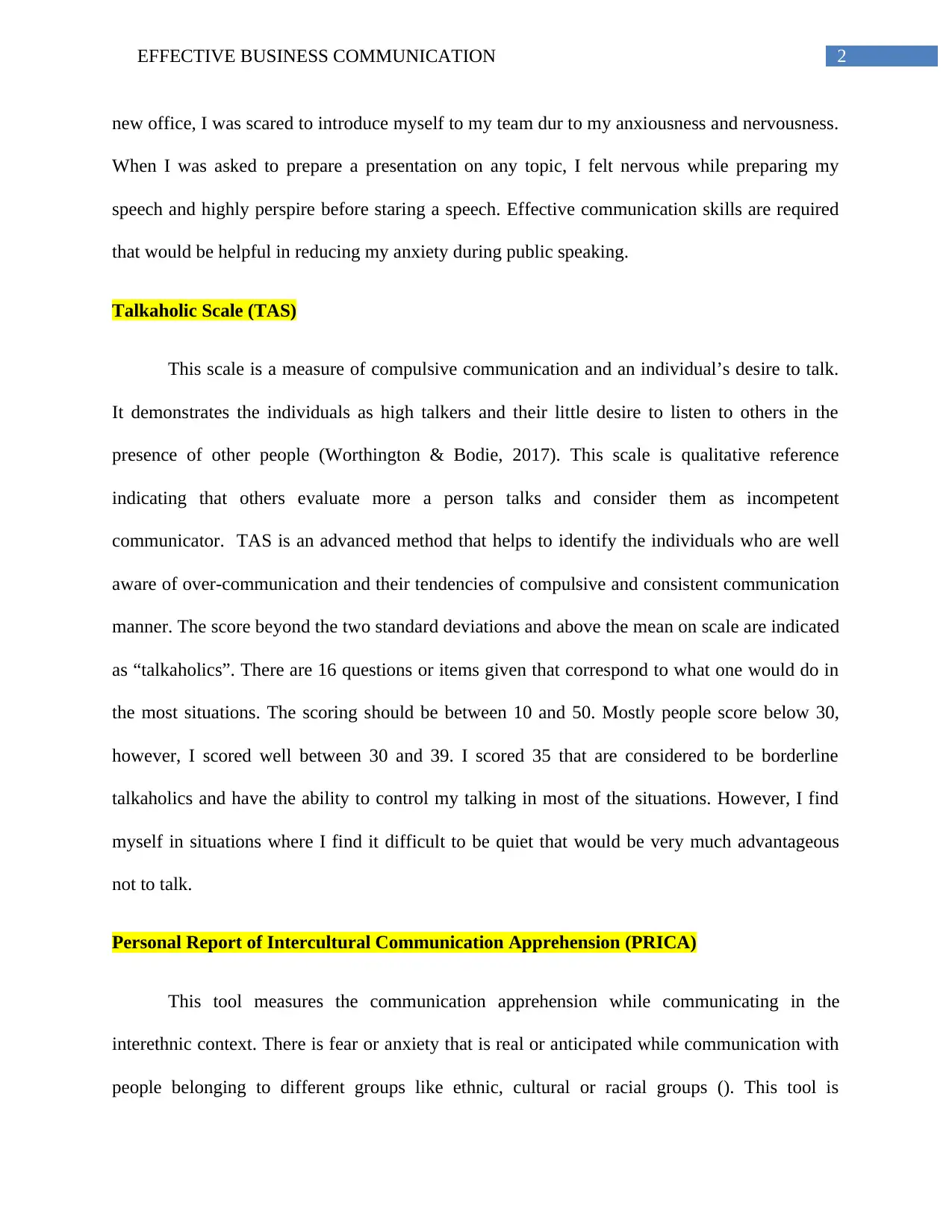
2EFFECTIVE BUSINESS COMMUNICATION
new office, I was scared to introduce myself to my team dur to my anxiousness and nervousness.
When I was asked to prepare a presentation on any topic, I felt nervous while preparing my
speech and highly perspire before staring a speech. Effective communication skills are required
that would be helpful in reducing my anxiety during public speaking.
Talkaholic Scale (TAS)
This scale is a measure of compulsive communication and an individual’s desire to talk.
It demonstrates the individuals as high talkers and their little desire to listen to others in the
presence of other people (Worthington & Bodie, 2017). This scale is qualitative reference
indicating that others evaluate more a person talks and consider them as incompetent
communicator. TAS is an advanced method that helps to identify the individuals who are well
aware of over-communication and their tendencies of compulsive and consistent communication
manner. The score beyond the two standard deviations and above the mean on scale are indicated
as “talkaholics”. There are 16 questions or items given that correspond to what one would do in
the most situations. The scoring should be between 10 and 50. Mostly people score below 30,
however, I scored well between 30 and 39. I scored 35 that are considered to be borderline
talkaholics and have the ability to control my talking in most of the situations. However, I find
myself in situations where I find it difficult to be quiet that would be very much advantageous
not to talk.
Personal Report of Intercultural Communication Apprehension (PRICA)
This tool measures the communication apprehension while communicating in the
interethnic context. There is fear or anxiety that is real or anticipated while communication with
people belonging to different groups like ethnic, cultural or racial groups (). This tool is
new office, I was scared to introduce myself to my team dur to my anxiousness and nervousness.
When I was asked to prepare a presentation on any topic, I felt nervous while preparing my
speech and highly perspire before staring a speech. Effective communication skills are required
that would be helpful in reducing my anxiety during public speaking.
Talkaholic Scale (TAS)
This scale is a measure of compulsive communication and an individual’s desire to talk.
It demonstrates the individuals as high talkers and their little desire to listen to others in the
presence of other people (Worthington & Bodie, 2017). This scale is qualitative reference
indicating that others evaluate more a person talks and consider them as incompetent
communicator. TAS is an advanced method that helps to identify the individuals who are well
aware of over-communication and their tendencies of compulsive and consistent communication
manner. The score beyond the two standard deviations and above the mean on scale are indicated
as “talkaholics”. There are 16 questions or items given that correspond to what one would do in
the most situations. The scoring should be between 10 and 50. Mostly people score below 30,
however, I scored well between 30 and 39. I scored 35 that are considered to be borderline
talkaholics and have the ability to control my talking in most of the situations. However, I find
myself in situations where I find it difficult to be quiet that would be very much advantageous
not to talk.
Personal Report of Intercultural Communication Apprehension (PRICA)
This tool measures the communication apprehension while communicating in the
interethnic context. There is fear or anxiety that is real or anticipated while communication with
people belonging to different groups like ethnic, cultural or racial groups (). This tool is
⊘ This is a preview!⊘
Do you want full access?
Subscribe today to unlock all pages.

Trusted by 1+ million students worldwide
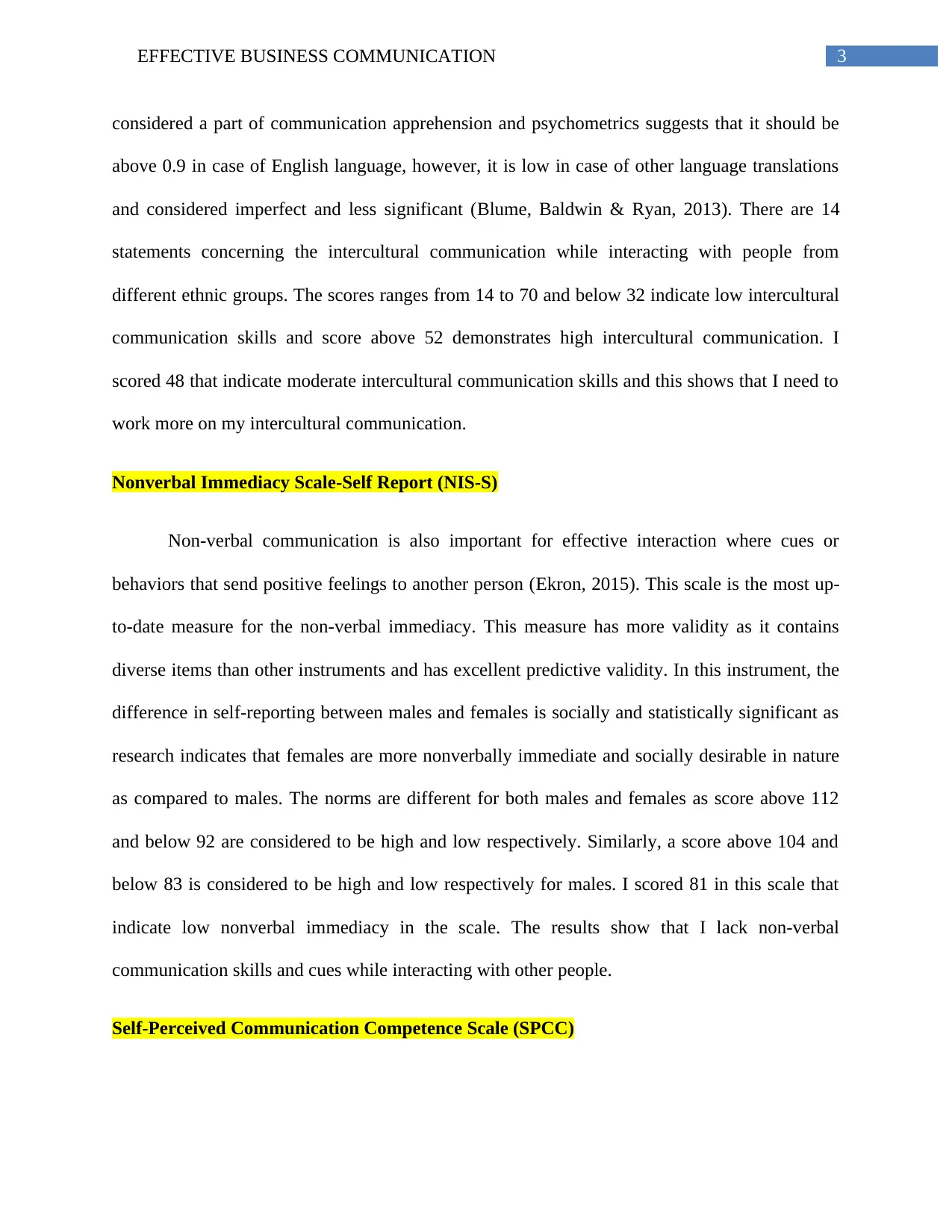
3EFFECTIVE BUSINESS COMMUNICATION
considered a part of communication apprehension and psychometrics suggests that it should be
above 0.9 in case of English language, however, it is low in case of other language translations
and considered imperfect and less significant (Blume, Baldwin & Ryan, 2013). There are 14
statements concerning the intercultural communication while interacting with people from
different ethnic groups. The scores ranges from 14 to 70 and below 32 indicate low intercultural
communication skills and score above 52 demonstrates high intercultural communication. I
scored 48 that indicate moderate intercultural communication skills and this shows that I need to
work more on my intercultural communication.
Nonverbal Immediacy Scale-Self Report (NIS-S)
Non-verbal communication is also important for effective interaction where cues or
behaviors that send positive feelings to another person (Ekron, 2015). This scale is the most up-
to-date measure for the non-verbal immediacy. This measure has more validity as it contains
diverse items than other instruments and has excellent predictive validity. In this instrument, the
difference in self-reporting between males and females is socially and statistically significant as
research indicates that females are more nonverbally immediate and socially desirable in nature
as compared to males. The norms are different for both males and females as score above 112
and below 92 are considered to be high and low respectively. Similarly, a score above 104 and
below 83 is considered to be high and low respectively for males. I scored 81 in this scale that
indicate low nonverbal immediacy in the scale. The results show that I lack non-verbal
communication skills and cues while interacting with other people.
Self-Perceived Communication Competence Scale (SPCC)
considered a part of communication apprehension and psychometrics suggests that it should be
above 0.9 in case of English language, however, it is low in case of other language translations
and considered imperfect and less significant (Blume, Baldwin & Ryan, 2013). There are 14
statements concerning the intercultural communication while interacting with people from
different ethnic groups. The scores ranges from 14 to 70 and below 32 indicate low intercultural
communication skills and score above 52 demonstrates high intercultural communication. I
scored 48 that indicate moderate intercultural communication skills and this shows that I need to
work more on my intercultural communication.
Nonverbal Immediacy Scale-Self Report (NIS-S)
Non-verbal communication is also important for effective interaction where cues or
behaviors that send positive feelings to another person (Ekron, 2015). This scale is the most up-
to-date measure for the non-verbal immediacy. This measure has more validity as it contains
diverse items than other instruments and has excellent predictive validity. In this instrument, the
difference in self-reporting between males and females is socially and statistically significant as
research indicates that females are more nonverbally immediate and socially desirable in nature
as compared to males. The norms are different for both males and females as score above 112
and below 92 are considered to be high and low respectively. Similarly, a score above 104 and
below 83 is considered to be high and low respectively for males. I scored 81 in this scale that
indicate low nonverbal immediacy in the scale. The results show that I lack non-verbal
communication skills and cues while interacting with other people.
Self-Perceived Communication Competence Scale (SPCC)
Paraphrase This Document
Need a fresh take? Get an instant paraphrase of this document with our AI Paraphraser
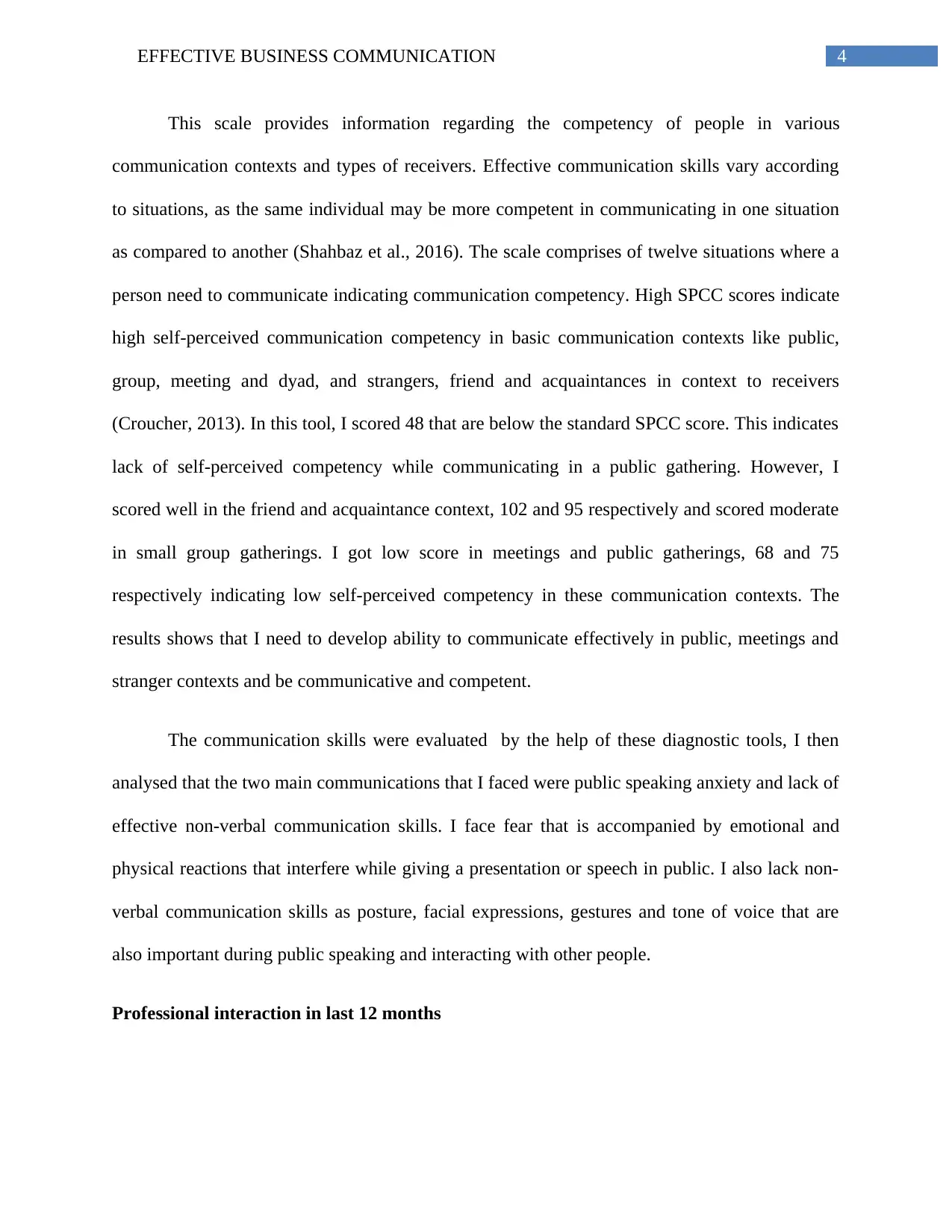
4EFFECTIVE BUSINESS COMMUNICATION
This scale provides information regarding the competency of people in various
communication contexts and types of receivers. Effective communication skills vary according
to situations, as the same individual may be more competent in communicating in one situation
as compared to another (Shahbaz et al., 2016). The scale comprises of twelve situations where a
person need to communicate indicating communication competency. High SPCC scores indicate
high self-perceived communication competency in basic communication contexts like public,
group, meeting and dyad, and strangers, friend and acquaintances in context to receivers
(Croucher, 2013). In this tool, I scored 48 that are below the standard SPCC score. This indicates
lack of self-perceived competency while communicating in a public gathering. However, I
scored well in the friend and acquaintance context, 102 and 95 respectively and scored moderate
in small group gatherings. I got low score in meetings and public gatherings, 68 and 75
respectively indicating low self-perceived competency in these communication contexts. The
results shows that I need to develop ability to communicate effectively in public, meetings and
stranger contexts and be communicative and competent.
The communication skills were evaluated by the help of these diagnostic tools, I then
analysed that the two main communications that I faced were public speaking anxiety and lack of
effective non-verbal communication skills. I face fear that is accompanied by emotional and
physical reactions that interfere while giving a presentation or speech in public. I also lack non-
verbal communication skills as posture, facial expressions, gestures and tone of voice that are
also important during public speaking and interacting with other people.
Professional interaction in last 12 months
This scale provides information regarding the competency of people in various
communication contexts and types of receivers. Effective communication skills vary according
to situations, as the same individual may be more competent in communicating in one situation
as compared to another (Shahbaz et al., 2016). The scale comprises of twelve situations where a
person need to communicate indicating communication competency. High SPCC scores indicate
high self-perceived communication competency in basic communication contexts like public,
group, meeting and dyad, and strangers, friend and acquaintances in context to receivers
(Croucher, 2013). In this tool, I scored 48 that are below the standard SPCC score. This indicates
lack of self-perceived competency while communicating in a public gathering. However, I
scored well in the friend and acquaintance context, 102 and 95 respectively and scored moderate
in small group gatherings. I got low score in meetings and public gatherings, 68 and 75
respectively indicating low self-perceived competency in these communication contexts. The
results shows that I need to develop ability to communicate effectively in public, meetings and
stranger contexts and be communicative and competent.
The communication skills were evaluated by the help of these diagnostic tools, I then
analysed that the two main communications that I faced were public speaking anxiety and lack of
effective non-verbal communication skills. I face fear that is accompanied by emotional and
physical reactions that interfere while giving a presentation or speech in public. I also lack non-
verbal communication skills as posture, facial expressions, gestures and tone of voice that are
also important during public speaking and interacting with other people.
Professional interaction in last 12 months
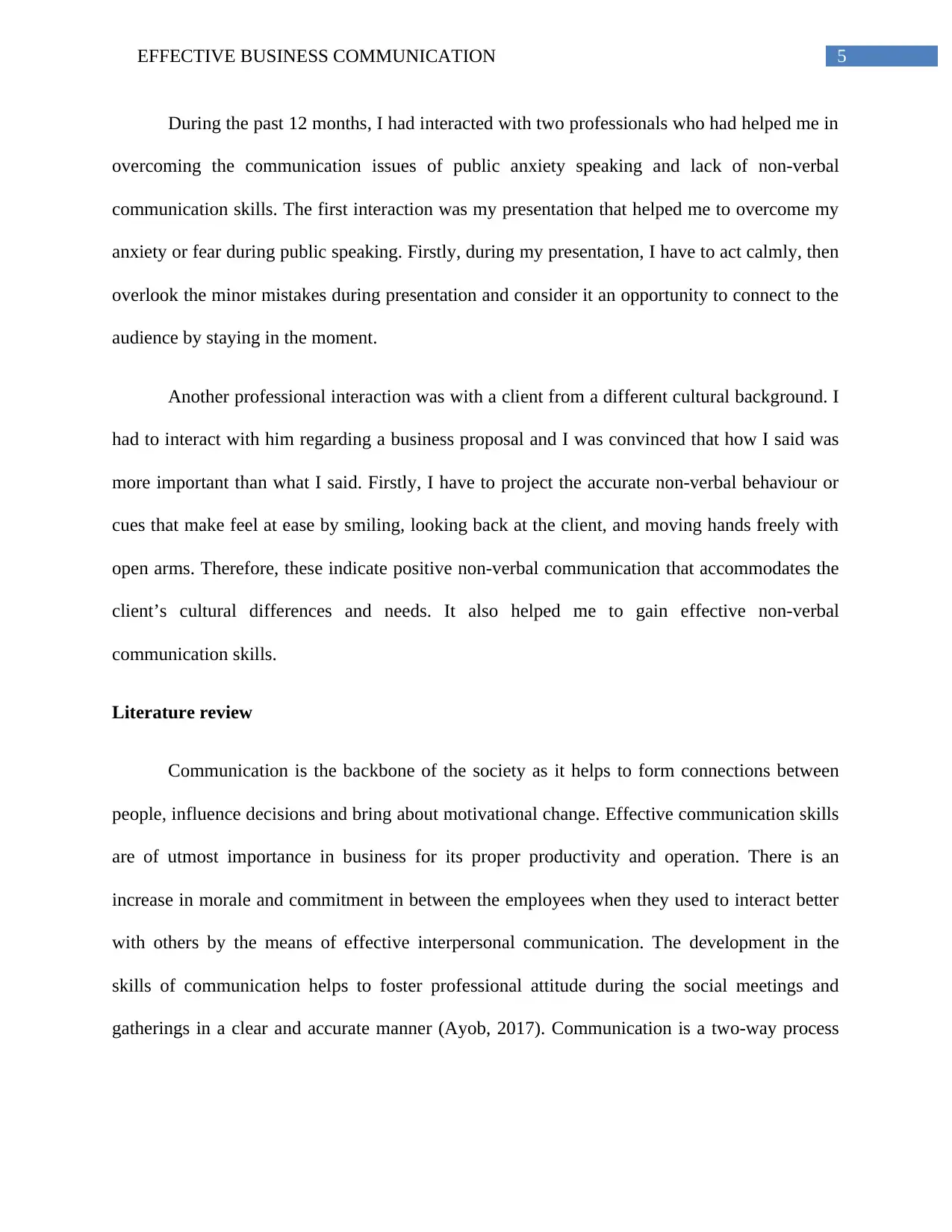
5EFFECTIVE BUSINESS COMMUNICATION
During the past 12 months, I had interacted with two professionals who had helped me in
overcoming the communication issues of public anxiety speaking and lack of non-verbal
communication skills. The first interaction was my presentation that helped me to overcome my
anxiety or fear during public speaking. Firstly, during my presentation, I have to act calmly, then
overlook the minor mistakes during presentation and consider it an opportunity to connect to the
audience by staying in the moment.
Another professional interaction was with a client from a different cultural background. I
had to interact with him regarding a business proposal and I was convinced that how I said was
more important than what I said. Firstly, I have to project the accurate non-verbal behaviour or
cues that make feel at ease by smiling, looking back at the client, and moving hands freely with
open arms. Therefore, these indicate positive non-verbal communication that accommodates the
client’s cultural differences and needs. It also helped me to gain effective non-verbal
communication skills.
Literature review
Communication is the backbone of the society as it helps to form connections between
people, influence decisions and bring about motivational change. Effective communication skills
are of utmost importance in business for its proper productivity and operation. There is an
increase in morale and commitment in between the employees when they used to interact better
with others by the means of effective interpersonal communication. The development in the
skills of communication helps to foster professional attitude during the social meetings and
gatherings in a clear and accurate manner (Ayob, 2017). Communication is a two-way process
During the past 12 months, I had interacted with two professionals who had helped me in
overcoming the communication issues of public anxiety speaking and lack of non-verbal
communication skills. The first interaction was my presentation that helped me to overcome my
anxiety or fear during public speaking. Firstly, during my presentation, I have to act calmly, then
overlook the minor mistakes during presentation and consider it an opportunity to connect to the
audience by staying in the moment.
Another professional interaction was with a client from a different cultural background. I
had to interact with him regarding a business proposal and I was convinced that how I said was
more important than what I said. Firstly, I have to project the accurate non-verbal behaviour or
cues that make feel at ease by smiling, looking back at the client, and moving hands freely with
open arms. Therefore, these indicate positive non-verbal communication that accommodates the
client’s cultural differences and needs. It also helped me to gain effective non-verbal
communication skills.
Literature review
Communication is the backbone of the society as it helps to form connections between
people, influence decisions and bring about motivational change. Effective communication skills
are of utmost importance in business for its proper productivity and operation. There is an
increase in morale and commitment in between the employees when they used to interact better
with others by the means of effective interpersonal communication. The development in the
skills of communication helps to foster professional attitude during the social meetings and
gatherings in a clear and accurate manner (Ayob, 2017). Communication is a two-way process
⊘ This is a preview!⊘
Do you want full access?
Subscribe today to unlock all pages.

Trusted by 1+ million students worldwide
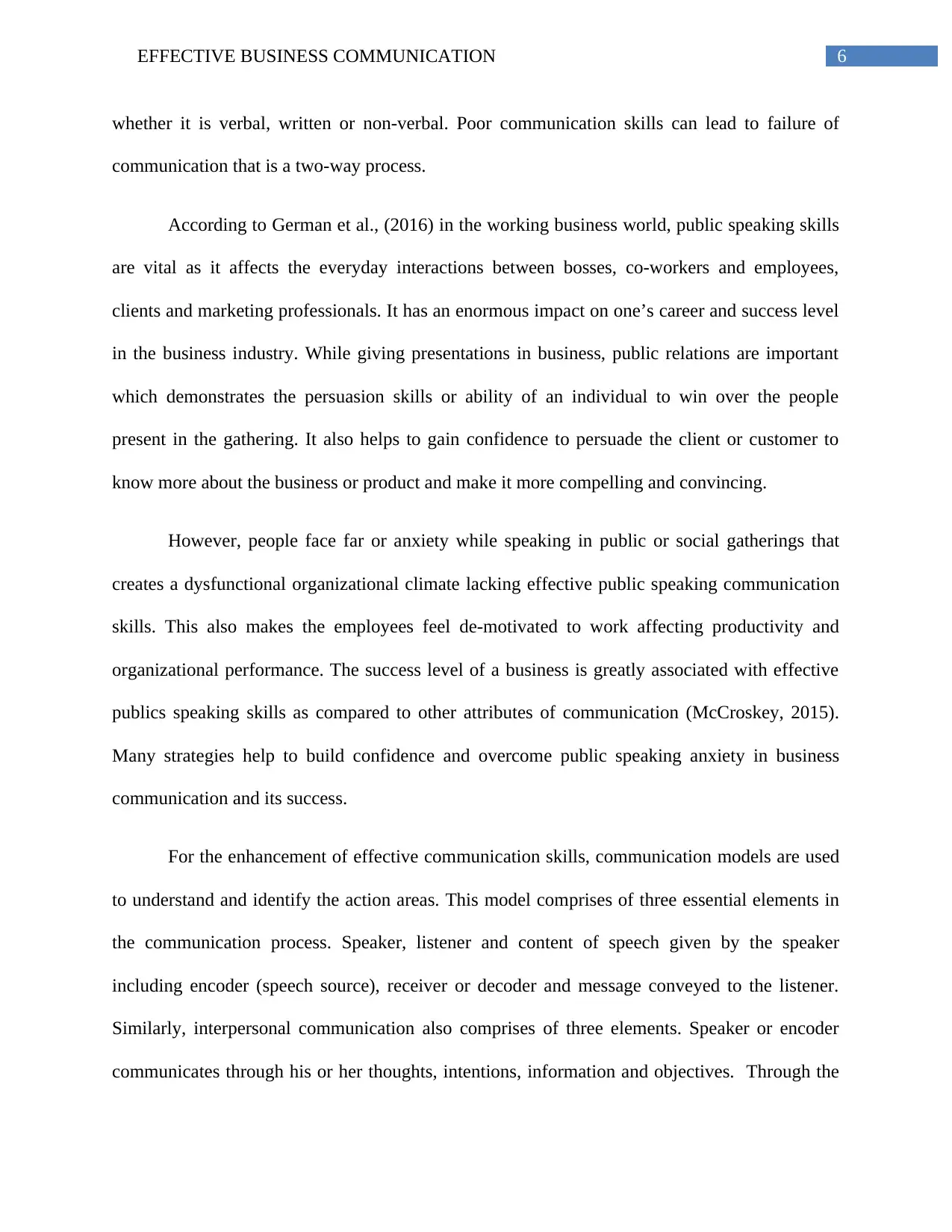
6EFFECTIVE BUSINESS COMMUNICATION
whether it is verbal, written or non-verbal. Poor communication skills can lead to failure of
communication that is a two-way process.
According to German et al., (2016) in the working business world, public speaking skills
are vital as it affects the everyday interactions between bosses, co-workers and employees,
clients and marketing professionals. It has an enormous impact on one’s career and success level
in the business industry. While giving presentations in business, public relations are important
which demonstrates the persuasion skills or ability of an individual to win over the people
present in the gathering. It also helps to gain confidence to persuade the client or customer to
know more about the business or product and make it more compelling and convincing.
However, people face far or anxiety while speaking in public or social gatherings that
creates a dysfunctional organizational climate lacking effective public speaking communication
skills. This also makes the employees feel de-motivated to work affecting productivity and
organizational performance. The success level of a business is greatly associated with effective
publics speaking skills as compared to other attributes of communication (McCroskey, 2015).
Many strategies help to build confidence and overcome public speaking anxiety in business
communication and its success.
For the enhancement of effective communication skills, communication models are used
to understand and identify the action areas. This model comprises of three essential elements in
the communication process. Speaker, listener and content of speech given by the speaker
including encoder (speech source), receiver or decoder and message conveyed to the listener.
Similarly, interpersonal communication also comprises of three elements. Speaker or encoder
communicates through his or her thoughts, intentions, information and objectives. Through the
whether it is verbal, written or non-verbal. Poor communication skills can lead to failure of
communication that is a two-way process.
According to German et al., (2016) in the working business world, public speaking skills
are vital as it affects the everyday interactions between bosses, co-workers and employees,
clients and marketing professionals. It has an enormous impact on one’s career and success level
in the business industry. While giving presentations in business, public relations are important
which demonstrates the persuasion skills or ability of an individual to win over the people
present in the gathering. It also helps to gain confidence to persuade the client or customer to
know more about the business or product and make it more compelling and convincing.
However, people face far or anxiety while speaking in public or social gatherings that
creates a dysfunctional organizational climate lacking effective public speaking communication
skills. This also makes the employees feel de-motivated to work affecting productivity and
organizational performance. The success level of a business is greatly associated with effective
publics speaking skills as compared to other attributes of communication (McCroskey, 2015).
Many strategies help to build confidence and overcome public speaking anxiety in business
communication and its success.
For the enhancement of effective communication skills, communication models are used
to understand and identify the action areas. This model comprises of three essential elements in
the communication process. Speaker, listener and content of speech given by the speaker
including encoder (speech source), receiver or decoder and message conveyed to the listener.
Similarly, interpersonal communication also comprises of three elements. Speaker or encoder
communicates through his or her thoughts, intentions, information and objectives. Through the
Paraphrase This Document
Need a fresh take? Get an instant paraphrase of this document with our AI Paraphraser
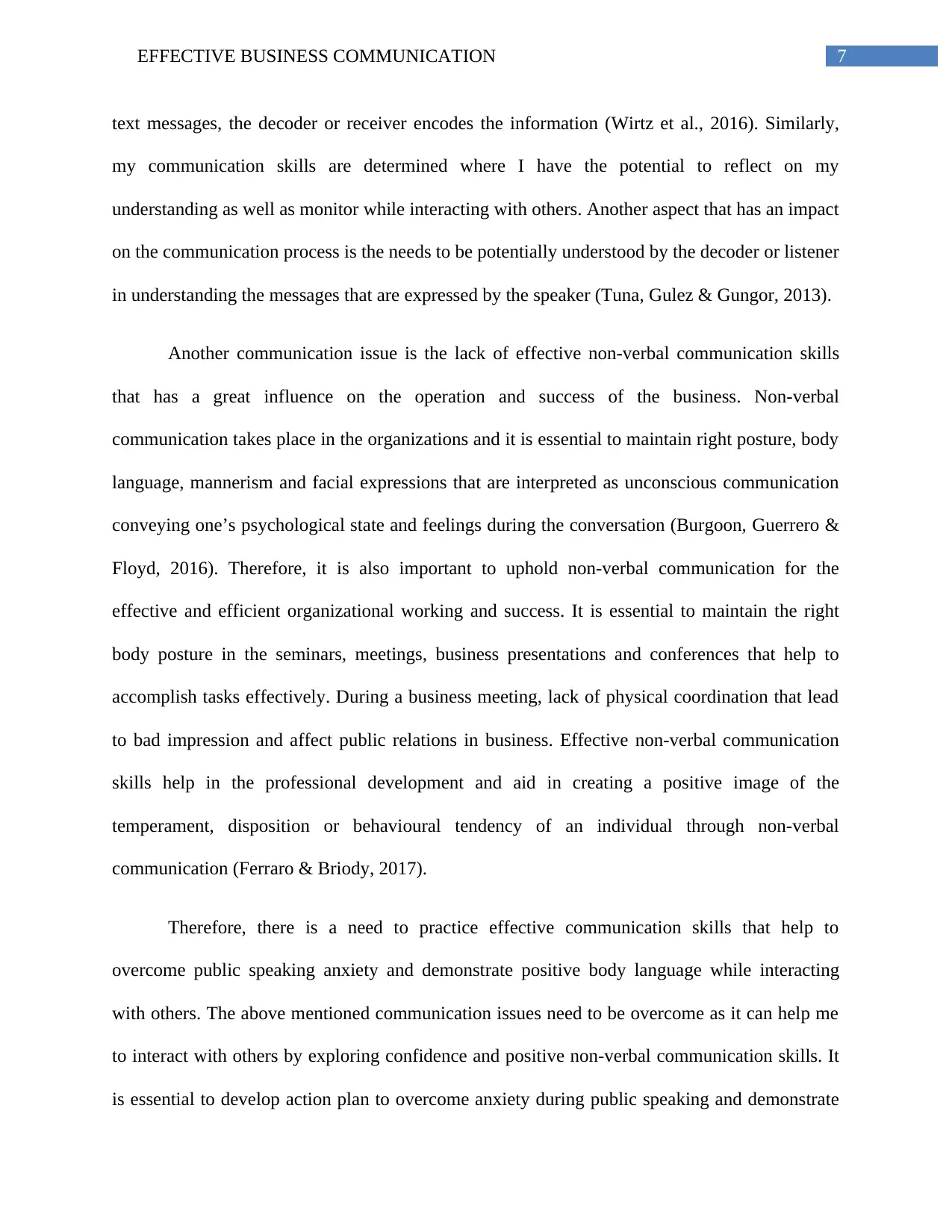
7EFFECTIVE BUSINESS COMMUNICATION
text messages, the decoder or receiver encodes the information (Wirtz et al., 2016). Similarly,
my communication skills are determined where I have the potential to reflect on my
understanding as well as monitor while interacting with others. Another aspect that has an impact
on the communication process is the needs to be potentially understood by the decoder or listener
in understanding the messages that are expressed by the speaker (Tuna, Gulez & Gungor, 2013).
Another communication issue is the lack of effective non-verbal communication skills
that has a great influence on the operation and success of the business. Non-verbal
communication takes place in the organizations and it is essential to maintain right posture, body
language, mannerism and facial expressions that are interpreted as unconscious communication
conveying one’s psychological state and feelings during the conversation (Burgoon, Guerrero &
Floyd, 2016). Therefore, it is also important to uphold non-verbal communication for the
effective and efficient organizational working and success. It is essential to maintain the right
body posture in the seminars, meetings, business presentations and conferences that help to
accomplish tasks effectively. During a business meeting, lack of physical coordination that lead
to bad impression and affect public relations in business. Effective non-verbal communication
skills help in the professional development and aid in creating a positive image of the
temperament, disposition or behavioural tendency of an individual through non-verbal
communication (Ferraro & Briody, 2017).
Therefore, there is a need to practice effective communication skills that help to
overcome public speaking anxiety and demonstrate positive body language while interacting
with others. The above mentioned communication issues need to be overcome as it can help me
to interact with others by exploring confidence and positive non-verbal communication skills. It
is essential to develop action plan to overcome anxiety during public speaking and demonstrate
text messages, the decoder or receiver encodes the information (Wirtz et al., 2016). Similarly,
my communication skills are determined where I have the potential to reflect on my
understanding as well as monitor while interacting with others. Another aspect that has an impact
on the communication process is the needs to be potentially understood by the decoder or listener
in understanding the messages that are expressed by the speaker (Tuna, Gulez & Gungor, 2013).
Another communication issue is the lack of effective non-verbal communication skills
that has a great influence on the operation and success of the business. Non-verbal
communication takes place in the organizations and it is essential to maintain right posture, body
language, mannerism and facial expressions that are interpreted as unconscious communication
conveying one’s psychological state and feelings during the conversation (Burgoon, Guerrero &
Floyd, 2016). Therefore, it is also important to uphold non-verbal communication for the
effective and efficient organizational working and success. It is essential to maintain the right
body posture in the seminars, meetings, business presentations and conferences that help to
accomplish tasks effectively. During a business meeting, lack of physical coordination that lead
to bad impression and affect public relations in business. Effective non-verbal communication
skills help in the professional development and aid in creating a positive image of the
temperament, disposition or behavioural tendency of an individual through non-verbal
communication (Ferraro & Briody, 2017).
Therefore, there is a need to practice effective communication skills that help to
overcome public speaking anxiety and demonstrate positive body language while interacting
with others. The above mentioned communication issues need to be overcome as it can help me
to interact with others by exploring confidence and positive non-verbal communication skills. It
is essential to develop action plan to overcome anxiety during public speaking and demonstrate
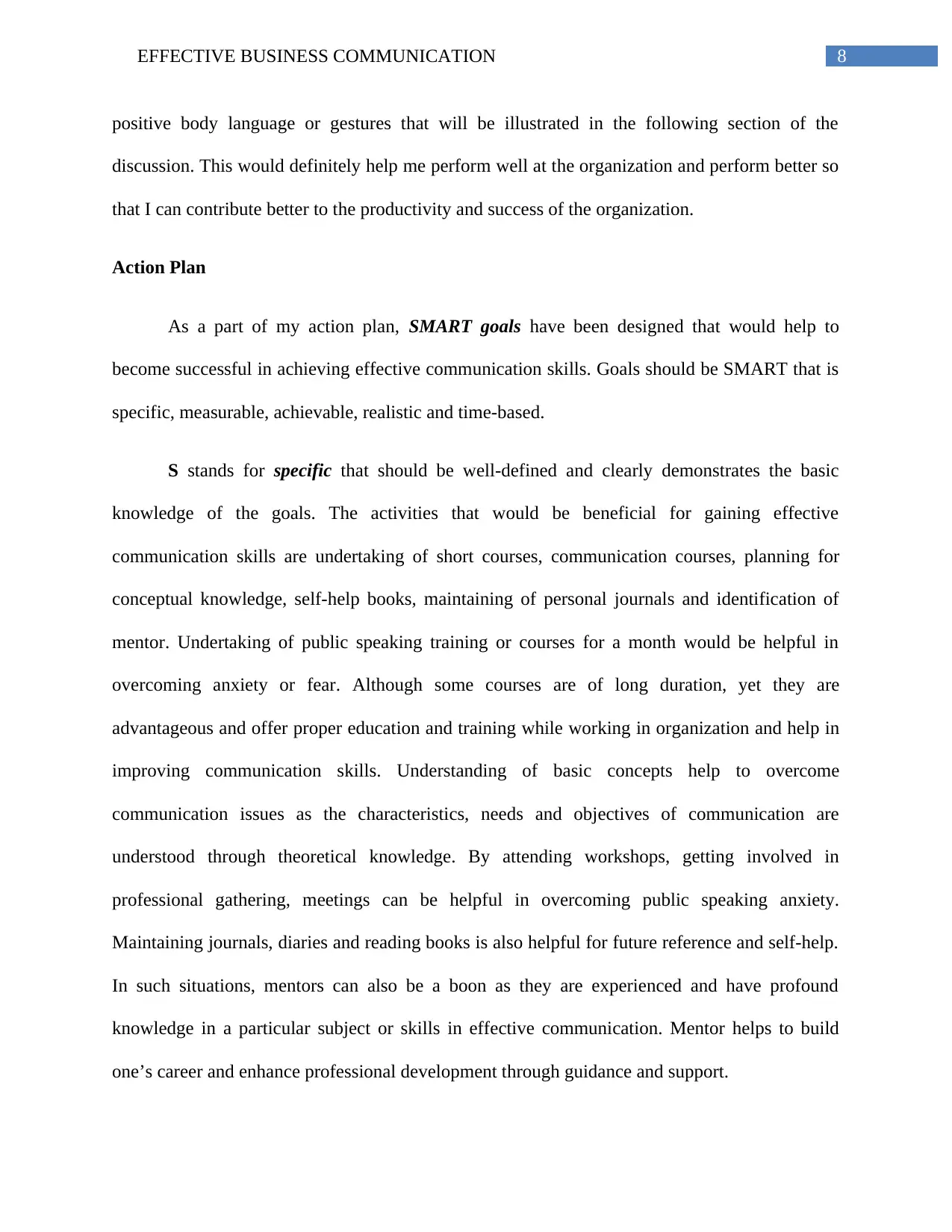
8EFFECTIVE BUSINESS COMMUNICATION
positive body language or gestures that will be illustrated in the following section of the
discussion. This would definitely help me perform well at the organization and perform better so
that I can contribute better to the productivity and success of the organization.
Action Plan
As a part of my action plan, SMART goals have been designed that would help to
become successful in achieving effective communication skills. Goals should be SMART that is
specific, measurable, achievable, realistic and time-based.
S stands for specific that should be well-defined and clearly demonstrates the basic
knowledge of the goals. The activities that would be beneficial for gaining effective
communication skills are undertaking of short courses, communication courses, planning for
conceptual knowledge, self-help books, maintaining of personal journals and identification of
mentor. Undertaking of public speaking training or courses for a month would be helpful in
overcoming anxiety or fear. Although some courses are of long duration, yet they are
advantageous and offer proper education and training while working in organization and help in
improving communication skills. Understanding of basic concepts help to overcome
communication issues as the characteristics, needs and objectives of communication are
understood through theoretical knowledge. By attending workshops, getting involved in
professional gathering, meetings can be helpful in overcoming public speaking anxiety.
Maintaining journals, diaries and reading books is also helpful for future reference and self-help.
In such situations, mentors can also be a boon as they are experienced and have profound
knowledge in a particular subject or skills in effective communication. Mentor helps to build
one’s career and enhance professional development through guidance and support.
positive body language or gestures that will be illustrated in the following section of the
discussion. This would definitely help me perform well at the organization and perform better so
that I can contribute better to the productivity and success of the organization.
Action Plan
As a part of my action plan, SMART goals have been designed that would help to
become successful in achieving effective communication skills. Goals should be SMART that is
specific, measurable, achievable, realistic and time-based.
S stands for specific that should be well-defined and clearly demonstrates the basic
knowledge of the goals. The activities that would be beneficial for gaining effective
communication skills are undertaking of short courses, communication courses, planning for
conceptual knowledge, self-help books, maintaining of personal journals and identification of
mentor. Undertaking of public speaking training or courses for a month would be helpful in
overcoming anxiety or fear. Although some courses are of long duration, yet they are
advantageous and offer proper education and training while working in organization and help in
improving communication skills. Understanding of basic concepts help to overcome
communication issues as the characteristics, needs and objectives of communication are
understood through theoretical knowledge. By attending workshops, getting involved in
professional gathering, meetings can be helpful in overcoming public speaking anxiety.
Maintaining journals, diaries and reading books is also helpful for future reference and self-help.
In such situations, mentors can also be a boon as they are experienced and have profound
knowledge in a particular subject or skills in effective communication. Mentor helps to build
one’s career and enhance professional development through guidance and support.
⊘ This is a preview!⊘
Do you want full access?
Subscribe today to unlock all pages.

Trusted by 1+ million students worldwide
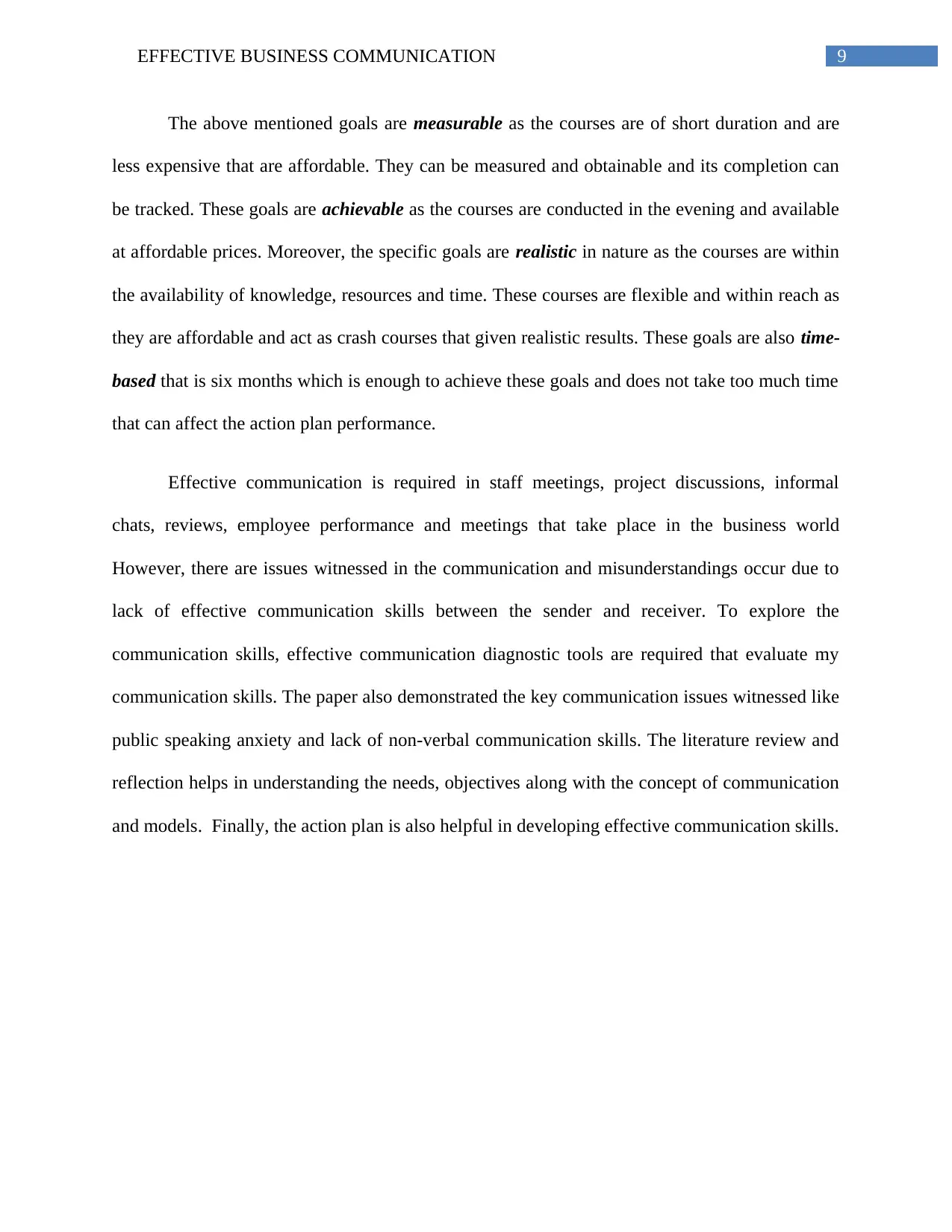
9EFFECTIVE BUSINESS COMMUNICATION
The above mentioned goals are measurable as the courses are of short duration and are
less expensive that are affordable. They can be measured and obtainable and its completion can
be tracked. These goals are achievable as the courses are conducted in the evening and available
at affordable prices. Moreover, the specific goals are realistic in nature as the courses are within
the availability of knowledge, resources and time. These courses are flexible and within reach as
they are affordable and act as crash courses that given realistic results. These goals are also time-
based that is six months which is enough to achieve these goals and does not take too much time
that can affect the action plan performance.
Effective communication is required in staff meetings, project discussions, informal
chats, reviews, employee performance and meetings that take place in the business world
However, there are issues witnessed in the communication and misunderstandings occur due to
lack of effective communication skills between the sender and receiver. To explore the
communication skills, effective communication diagnostic tools are required that evaluate my
communication skills. The paper also demonstrated the key communication issues witnessed like
public speaking anxiety and lack of non-verbal communication skills. The literature review and
reflection helps in understanding the needs, objectives along with the concept of communication
and models. Finally, the action plan is also helpful in developing effective communication skills.
The above mentioned goals are measurable as the courses are of short duration and are
less expensive that are affordable. They can be measured and obtainable and its completion can
be tracked. These goals are achievable as the courses are conducted in the evening and available
at affordable prices. Moreover, the specific goals are realistic in nature as the courses are within
the availability of knowledge, resources and time. These courses are flexible and within reach as
they are affordable and act as crash courses that given realistic results. These goals are also time-
based that is six months which is enough to achieve these goals and does not take too much time
that can affect the action plan performance.
Effective communication is required in staff meetings, project discussions, informal
chats, reviews, employee performance and meetings that take place in the business world
However, there are issues witnessed in the communication and misunderstandings occur due to
lack of effective communication skills between the sender and receiver. To explore the
communication skills, effective communication diagnostic tools are required that evaluate my
communication skills. The paper also demonstrated the key communication issues witnessed like
public speaking anxiety and lack of non-verbal communication skills. The literature review and
reflection helps in understanding the needs, objectives along with the concept of communication
and models. Finally, the action plan is also helpful in developing effective communication skills.
Paraphrase This Document
Need a fresh take? Get an instant paraphrase of this document with our AI Paraphraser
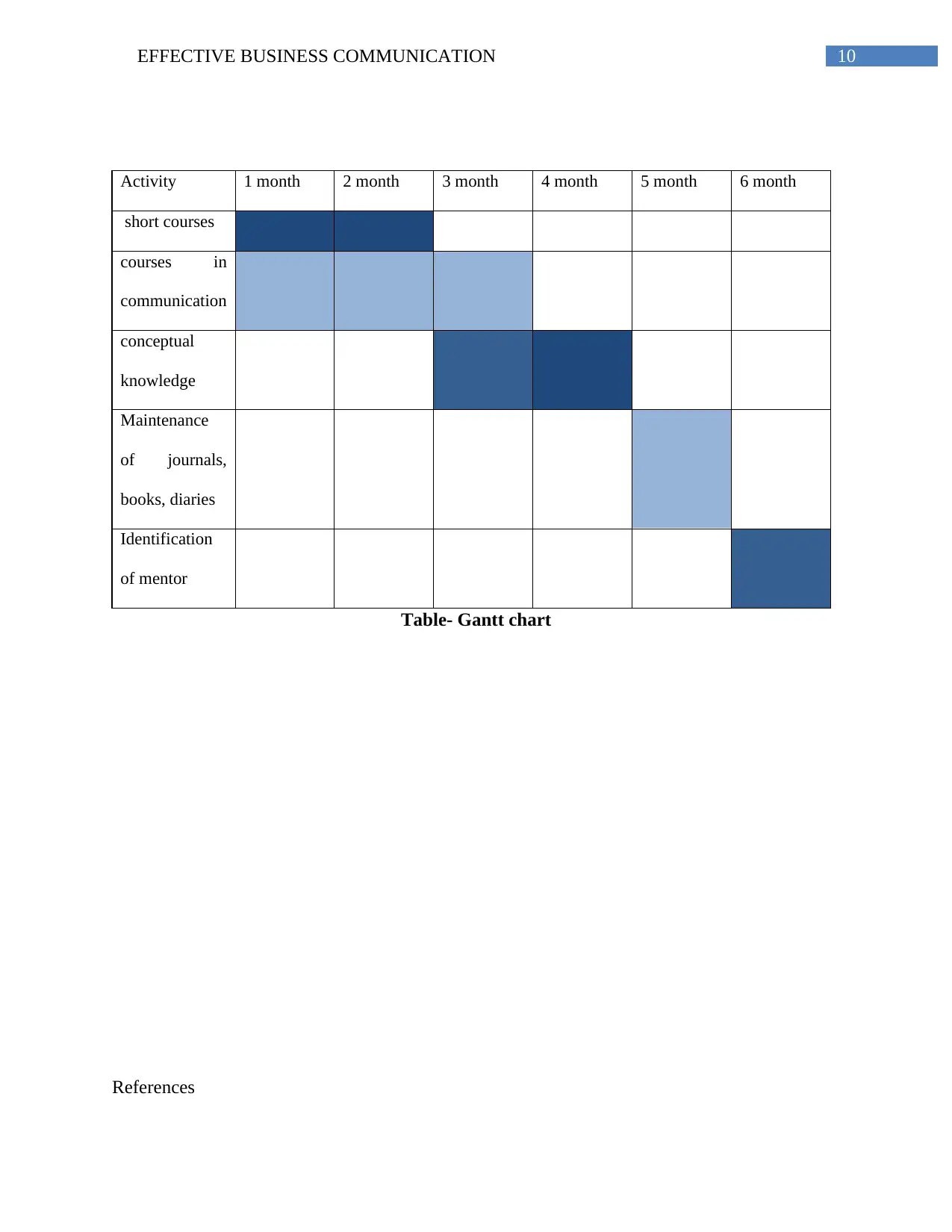
10EFFECTIVE BUSINESS COMMUNICATION
Activity 1 month 2 month 3 month 4 month 5 month 6 month
short courses
courses in
communication
conceptual
knowledge
Maintenance
of journals,
books, diaries
Identification
of mentor
Table- Gantt chart
References
Activity 1 month 2 month 3 month 4 month 5 month 6 month
short courses
courses in
communication
conceptual
knowledge
Maintenance
of journals,
books, diaries
Identification
of mentor
Table- Gantt chart
References
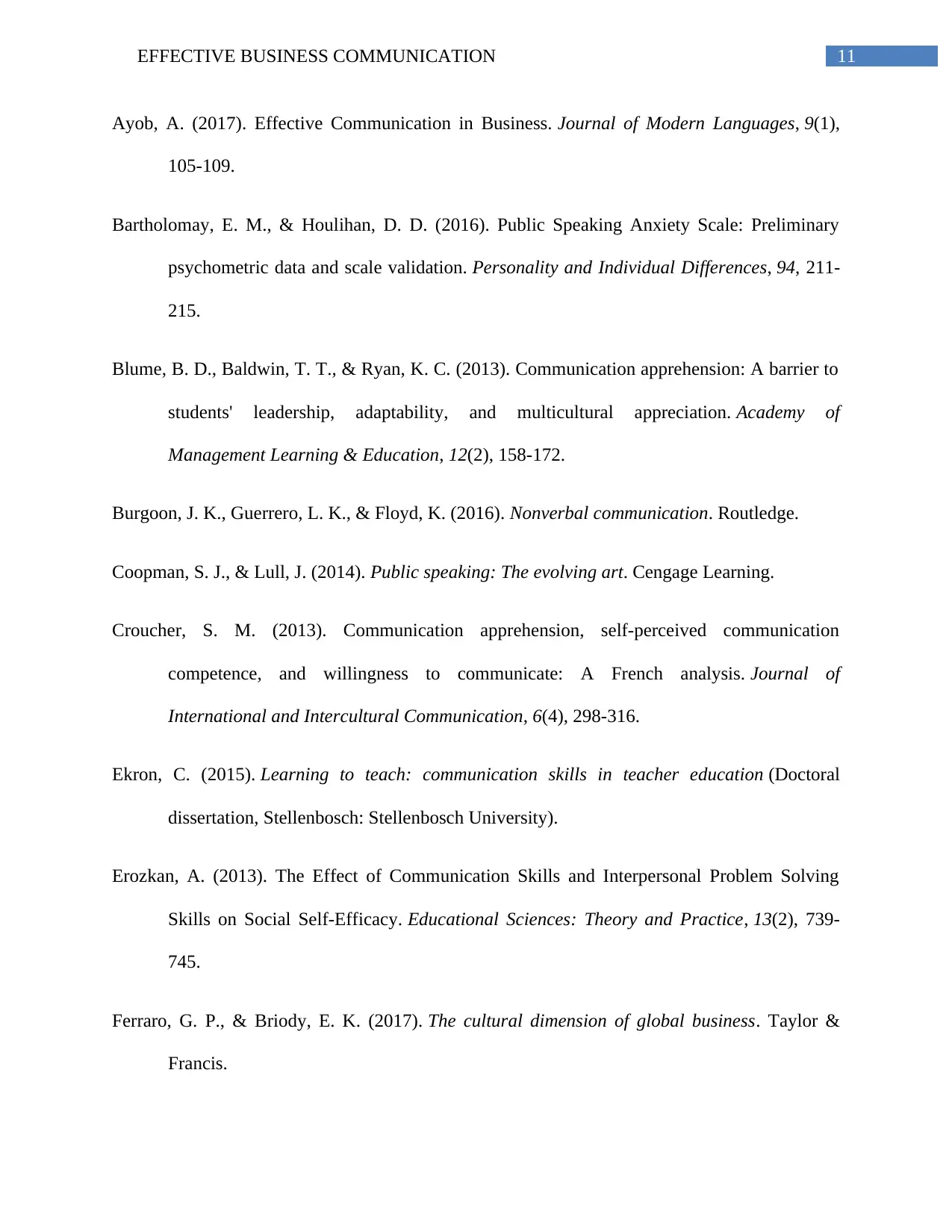
11EFFECTIVE BUSINESS COMMUNICATION
Ayob, A. (2017). Effective Communication in Business. Journal of Modern Languages, 9(1),
105-109.
Bartholomay, E. M., & Houlihan, D. D. (2016). Public Speaking Anxiety Scale: Preliminary
psychometric data and scale validation. Personality and Individual Differences, 94, 211-
215.
Blume, B. D., Baldwin, T. T., & Ryan, K. C. (2013). Communication apprehension: A barrier to
students' leadership, adaptability, and multicultural appreciation. Academy of
Management Learning & Education, 12(2), 158-172.
Burgoon, J. K., Guerrero, L. K., & Floyd, K. (2016). Nonverbal communication. Routledge.
Coopman, S. J., & Lull, J. (2014). Public speaking: The evolving art. Cengage Learning.
Croucher, S. M. (2013). Communication apprehension, self-perceived communication
competence, and willingness to communicate: A French analysis. Journal of
International and Intercultural Communication, 6(4), 298-316.
Ekron, C. (2015). Learning to teach: communication skills in teacher education (Doctoral
dissertation, Stellenbosch: Stellenbosch University).
Erozkan, A. (2013). The Effect of Communication Skills and Interpersonal Problem Solving
Skills on Social Self-Efficacy. Educational Sciences: Theory and Practice, 13(2), 739-
745.
Ferraro, G. P., & Briody, E. K. (2017). The cultural dimension of global business. Taylor &
Francis.
Ayob, A. (2017). Effective Communication in Business. Journal of Modern Languages, 9(1),
105-109.
Bartholomay, E. M., & Houlihan, D. D. (2016). Public Speaking Anxiety Scale: Preliminary
psychometric data and scale validation. Personality and Individual Differences, 94, 211-
215.
Blume, B. D., Baldwin, T. T., & Ryan, K. C. (2013). Communication apprehension: A barrier to
students' leadership, adaptability, and multicultural appreciation. Academy of
Management Learning & Education, 12(2), 158-172.
Burgoon, J. K., Guerrero, L. K., & Floyd, K. (2016). Nonverbal communication. Routledge.
Coopman, S. J., & Lull, J. (2014). Public speaking: The evolving art. Cengage Learning.
Croucher, S. M. (2013). Communication apprehension, self-perceived communication
competence, and willingness to communicate: A French analysis. Journal of
International and Intercultural Communication, 6(4), 298-316.
Ekron, C. (2015). Learning to teach: communication skills in teacher education (Doctoral
dissertation, Stellenbosch: Stellenbosch University).
Erozkan, A. (2013). The Effect of Communication Skills and Interpersonal Problem Solving
Skills on Social Self-Efficacy. Educational Sciences: Theory and Practice, 13(2), 739-
745.
Ferraro, G. P., & Briody, E. K. (2017). The cultural dimension of global business. Taylor &
Francis.
⊘ This is a preview!⊘
Do you want full access?
Subscribe today to unlock all pages.

Trusted by 1+ million students worldwide
1 out of 13
Related Documents
Your All-in-One AI-Powered Toolkit for Academic Success.
+13062052269
info@desklib.com
Available 24*7 on WhatsApp / Email
![[object Object]](/_next/static/media/star-bottom.7253800d.svg)
Unlock your academic potential
Copyright © 2020–2025 A2Z Services. All Rights Reserved. Developed and managed by ZUCOL.




